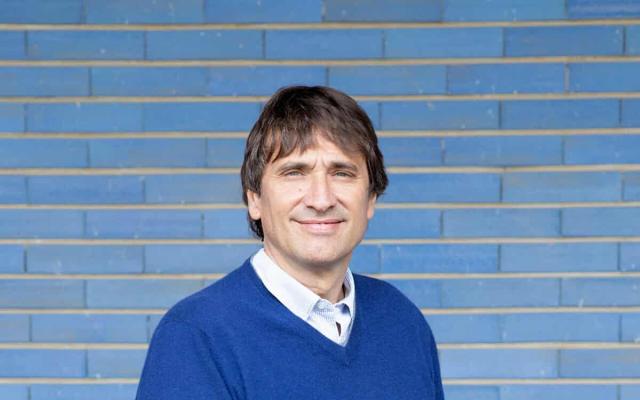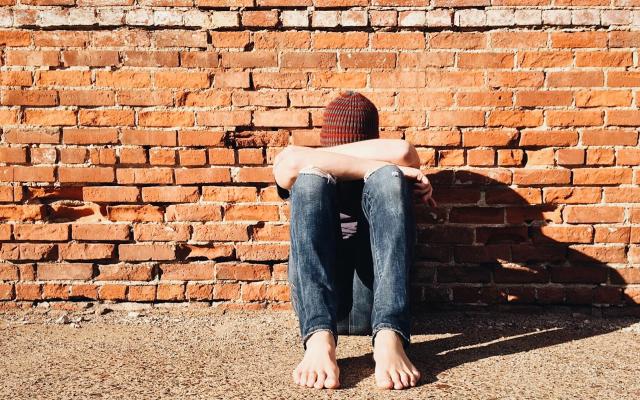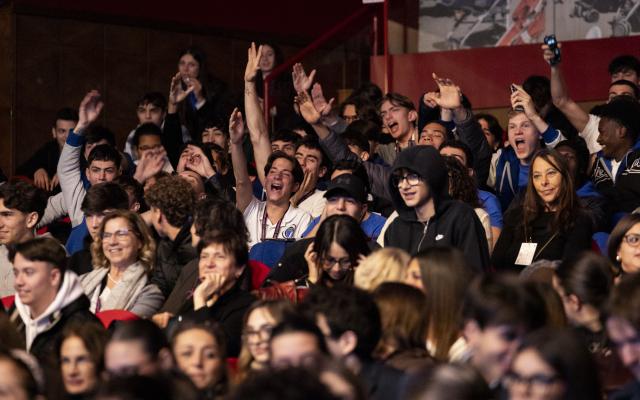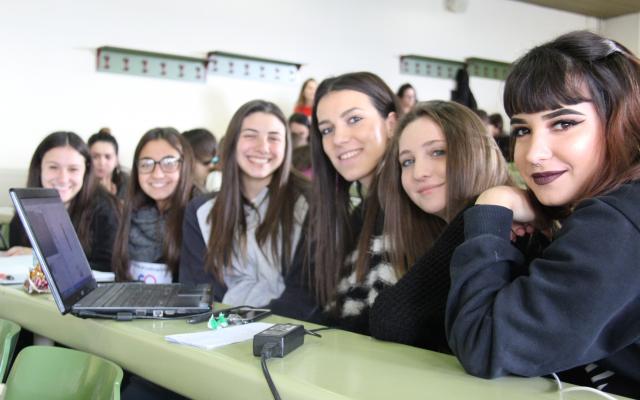An immersive didactic adventure in chemistry between school and university in Palermo.
During the school year that has just ended, three classes of the Liceo Felicia e Peppino Impastato in Partinico, in the Province of Palermo, started a didactic experiment in a custom-built virtual space on the Spatial.io Platform, under the guidance of professors at the Department of Biological, Chemical and Pharmaceutical Sciences and Technologies at the University of Palermo. In the metaverse, students manipulated accurate digital representations of different molecules, such as insulin, glucose, myoglobin, haemoglobin, ethanol, and mannose. Then, they participated in a hackathon to collaboratively develop solutions to the challenge of climate change: for example, with an effective 3D representation of biethic acid they showed an interesting application of the molecule for packaging with a low environmental impact [see news: Five Challenges for the Climate].
The Spatial.io Platform, providing advanced virtual reality (VR) and augmented reality (AR) capabilities, allowed the students to share, interact, and collaborate in three-dimensional virtual spaces. Coordinated by Professor Rosanna Amato, the young researchers undertook an original journey into virtual space guided by professors Antonella Maggio and Renato Lombardo from the UNIPA Department of Chemistry. The scientific journey won everyone over. After an introduction on the importance of models for the simplified representation of reality, in particular for the microscopic world of chemistry, students manipulated accurate digital representations of various molecules in the metaverse.
But how do you manage to create such a complex educational experience and also transform it into a compelling hackathon? Antonella Maria Maggio, Associate Professor and mentor at the Department of Chemistry of the University of Palermo, helps us understand this fascinating journey. We had an interesting long-distance conversation, in which she also revealed the difficulties encountered and the unexpected satisfactions. The whole undertaking was born from an informal chat between Delia Chillura and Salvatore Micciché, full professors at the Department, and Cecilia Stajano, Manager of the Coding Girls Programme in Italy, who launched the challenge: how to implement the programme in an original manner in the Palermo area? And if Meta were to donate Quest 2 visors, how would you use them?
“With Professor Renato Lombardo, we started from the idea of making people understand the potential and limits of the models with which we represent molecules. Even those with little knowledge of chemistry know that a molecule can be represented simply by indicating the type and number of atoms, for example H2O indicates that water has two hydrogen and one oxygen atom. However, the same water molecule can be represented by a three-dimensional model: spheres representing the atoms and segments representing the bonds. This mode adds more information as it reveals how the atoms are arranged relative to each other, and therefore accounts for some of the molecule’s properties. And gradually, via different levels, we arrive at the cartoon representation of the most complex molecules, such as sugars and proteins, which are very useful in biology and life sciences where the detail of the atomic composition is lost in order to have an overall three-dimensional vision. For these molecules, the need to represent their interactions is important, even to the detriment of the atomic vision,” explains the Prof. Antonella. “At the same time, we must never lose sight of the fact that each representation is just an alternative way of looking at a problem and that, depending on the case, we can use one or the other. We therefore imagined a path that starting from the representation of small molecules gradually arrived at the representation of more complex molecules. We also wanted to go further, also describing how the geometry of the molecules can then determine the larger structures into which they aggregate, such as liquid crystals.”
It was the department’s first foray into education through virtual reality. “We had been thinking about creating something like this for a while, also because our university had begun to encourage teaching experimentation and promote the use of innovative tools. Both Renato and I had had the opportunity to use visors and VR, but what was proposed for chemistry were mostly lab environments. Instead, we wanted to try to grasp the added value that these tools can provide when moving into contexts that are further from reality, such as the sub-microscopic world. We tried to design something in AR with simple smartphone apps, but this was the first opportunity to create something in immersive VR with dedicated visors. Thanks to a series of fortunate connections, Salvatore Miccichè had talked about the Coding Girls Programme a year ago with Delia Chillura, with whom we had shared these ideas several times. Planning and implementation were very complex both due to logistical difficulties, some of which were truly unpredictable, and didactic difficulties: identifying suitable objectives, simple but effective activities, how to evaluate the results.”
Obviously, the strictly educational aspect intrigues us a lot, especially understanding how much the results matched the expectations and declared objectives. “Very honestly, the results were truly unexpected for the most part,” replies Antonella. “Having never designed anything in VR, we initially set ourselves minimal goals. Most of the time was spent by Renato studying to choose the most suitable platform, designing the virtual space, understanding how to import the molecular models, then the rest became a game. We immediately understood that it could be an educationally stimulating activity because we, who had designed it, were captivated by it. I still remember the enthusiasm of being face-to-face with haemoglobin and perceiving the dimensional relationship between the heme group and the protein chain.”
Many people are sceptical about the potential of the metaverse. How does a still developing technology adapt to such a particular discipline as chemistry? “For chemistry, proposals generally address lab activities, which can be very useful for the preparation of a real laboratory activities. However, our interest was to show the invisible,” replies Antonella. “The difficulties were not few. In the meantime, we had to plan a course with clear objectives and a sequence of activities consistent with its objectives. The, it was necessary to develop all the elements. The biggest risk was that the tool itself would dominate over the concepts, which is a recurring risk in teaching with innovative methodologies. And for the first part of the activity this aspect is evident. The students were fascinated by the possibility of accessing a different world. Then, there was the difficulty of using the tool itself, which however was easily overcome, since the controls of the visors are truly user friendly.”
At present, it is an experimental experience, with reserved credentials. What would it take to transform it into an open, "turnkey" experience to be shared with schools? “Not much I think from the point of view of the teaching proposal. A bit of training for teachers would probably be necessary.”
At the beginning, the idea of creating a hackathon raised more than a few doubts. But this is how it was resolved: “This step was not without difficulties. We spent a lot of time and resources imagining a challenge. The idea was to have the students participate in the creation of the virtual space, just as we had done. That's why we had to train them. We then chose molecules that fell within the theme of the hackathon and assigned them to the groups by drawing lots. Apart from the logistical difficulties (Wi-Fi, organization of spaces, availability of computers), everything went better than we had expected. The groups worked with passion and tenacity, creating truly surprising work in terms of care and attention. The jury, made up of the Coordinator of the Degree Course in Chemistry at the University of Palermo, the Delegate to the Third Mission of the STEBICEF Department, our department, and a doctoral student of the Doctorate in Technologies and Methods for University Education, connected from Turin, followed presentations with virtual reality visors. It was a surprising experience for them, too.”
Once the task is done, what remains is satisfaction and a passion for teaching that can never be satisfied: “In chemistry, there are so many possibilities and access to the microscopic world is an enormous potential for learning this discipline. You can play with molecules for a long time.” For Antonella, the potential of the metaverse for training, education, and university is vast. “A great deal of didactic planning is needed because there is a risk of trivialization and the tool becoming the method, the means becoming the end.”




